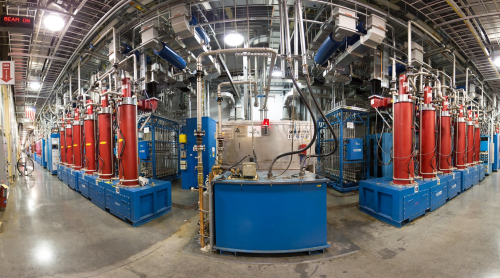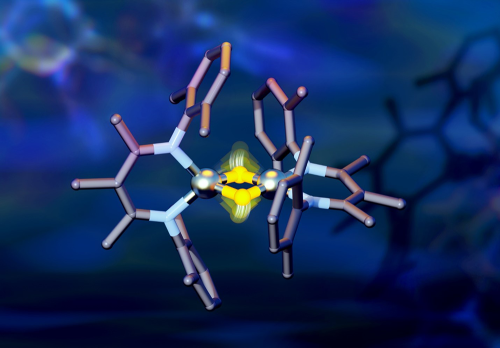The accelerator’s higher power provides more neutrons for researchers who use the facility to study and improve a wide range of materials for more efficient solar panels, longer lasting batteries and stronger, lighter materials for transportation.
The achievement marks a new operational milestone for neutron scattering in the United States and opens the door to tackling more difficult questions and problems in materials science research.

The red and blue klystrons at the Spallation Neutron Source help power the proton beam used to produce neutrons for materials research at Oak Ridge National Laboratory. Credit: Genevieve Martin/ORNL
Since construction was completed in 2006, the SNS has been a world-leading DOE Office of Science user facility that provides powerful advanced scientific capabilities for thousands of researchers from around the world to study energy phenomena and materials from the atomic scale to mesoscales.
As an example, earlier this month, ORNL reported that researchers from Yale University used the SNS to study hydrogen atom locations and their effects on iron in a compound similar to those commonly used in industrial catalysts. In the study, the researchers discovered that hydrogen atoms move around the core of the molecule rapidly, causing the energy levels of electrons in the attached iron atoms to shift significantly. The speed of their movement was controlled by slight changes in the surroundings of the molecule, showing surprising sensitivity.

Even small movements of hydrogen, shown in yellow, were found to cause large energy shifts in the attached iron atoms, shown in silver, which could be of interest in creating novel chemical reactions. Credit: Jill Hemman/ORNL, US Dept. of Energy
Neutron diffraction experiments at ORNL’s Spallation Neutron Source were used to locate the precise positions of the hydrogen atoms. The data will also be useful for novel catalyst designs.
The facility produces neutrons by accelerating protons down a 300-meter-long linear accelerator and into a liquid mercury target. Upon impact, a “spall” of neutrons is routed to surrounding high-powered research instruments, which enables scientists to guide the neutrons used to study the atomic structure and behavior of various materials. Neutrons scatter off atoms within the material and are captured by high-speed detectors, revealing fundamental information for research teams to analyze.
A megawatt is a unit of measure of the beam power of a particle accelerator. The SNS’ 1.55-megawatt power level was reached after the recent installation of additional accelerating systems, part of the ongoing Proton Power Upgrade project at the accelerator.
ORNL’s Proton Power Upgrade will continue to push the linear accelerator’s power capability up to 2.8 megawatts. This will increase the number of neutrons available for experiments at the existing First Target Station to enable new discoveries and power the planned Second Target Station, a complementary third neutron source at ORNL. STS will address emerging science challenges through experiments not currently feasible nor routine, with the ability to study smaller or less concentrated samples or those under more extreme environmental conditions.
Besides SNS, ORNL is home to the High Flux Isotope Reactor. Completed in 1965 and operating at 85 megawatts, HFIR’s steady-state neutron beam is the strongest reactor-based neutron source in the United States.
The SNS and HFIR are DOE Office of Science user facilities.